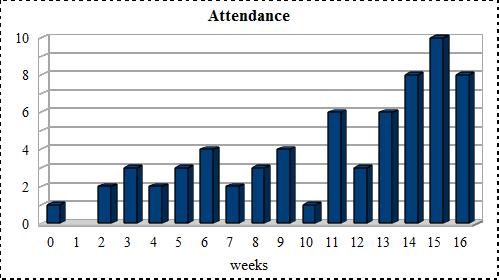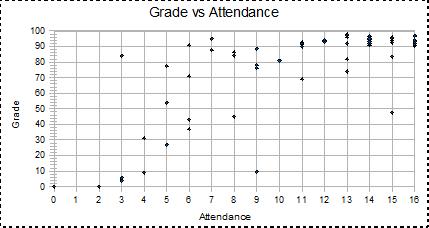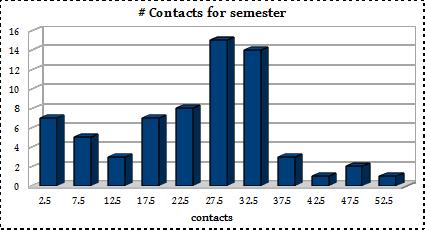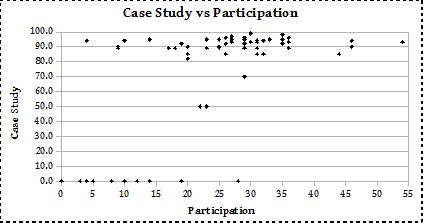TwoOldGuys™ e-Publishing
a service of LaFrance Consulting Services™
“eNutrition 101, Nursing flavor”
Assessment of Student Learning
Abstract
TwoOldGuys™ eNutrition 101, Nursing Flavor is an effective means
for your students to learn the basic concepts of Nutrition Science, and the practical application
of this knowledge to the practice of Nursing. The Final Exam was a term paper reporting the
results of a Case Study in which each student analyzed the nutritional value of a different
actual patient's diet and suggested ways to improve the patient's diet to promote Wellness. The
Case Study grade distribution was as follows:
{A = 53%; B = 21%; C = 2%; D & F = 24%},
suggesting that those who learned from the course, learned well. On the other hand, those
who learned less, learned very little.
Participation, defined as number of contacts for the semester, as an estimate of
the extent to which the student followed the stated procedures was distributed as follows:
{more than required = 44%; minimum required = 2%; less
than required = 31%; much less than required = 23%}
The Case Study grade distribution was correlated [significant at the 95% confidence level]
with Participation, supporting the conclusion that those students who complete the course work
learn. The regression line:
(Case Study) = 1.95 times (Participation) +
26.09,
mathematically describes the predictive value of Participation for determining Case
Study scores.
Introduction
The TwoOldGuys™ eNutrition course has been designed to implement my teaching methods [which
are ‘non-traditional,’ and have been called ‘constructivist’] in a web-based
environment. This course is described as “independent study” rather than as an
“on-line course,” because it consists entirely of written ‘lectures’ (adapted
from my in-class lecture notes, with references to the textbook) and
‘quizzes’ (focused on the key topic(s) of the lecture as it applies to the Nursing
profession). Students are expected to read the lectures, then answer the essay question(s) on the
quizzes using the textbook and other sources (print or on-line). Some of the quizzes are
‘discovery’ exercises, in which the students must conduct a brief independent study to
discover the principle underlying the concept.
The better students understand that this implies directed [by the lecture content] independent
research on Nutrition topics.
Based on comments solicited from students for assessment, all of the students who have taken other
on-line courses agree that this course is “unlike any other on-line course I have
taken.” But, is different necessarily a good thing? After all, traditional methods of
teaching seem to have done an adequate job of meeting the underlying purposes of Liberal Arts
College education, which are
(a) to transfer Knowledge from the professor to the students,
(b) to have the students learn in such a way that they can apply
this newly acquired Knowledge to Real World situations, and
(c) to help the students develop Critical Thinking skills and
apply these skills for problem solving.
We have anecdotal evidence that the design of TwoOldGuys™ eNutrition
101 may facilitate student learning. During a recent semester, 31 of 31 students who provided
feedback were strongly positive about their perceived learning (selected examples of student
feedback can be found at comments on eNutrition 101). However, as a
well-educated person accustomed to using Critical Thinking, you are no doubt skeptical about
anecdotal evidence. Obviously, the examples were selected to portray our product in a favorable
light; and are therefore merely “testimonials from satisfied former students.”
Why should you expect anything less than an ‘academic assessment,’ held to the standards
of clinical trials, to verify that student learning can be expected from an innovative approach
to pre-requisite courses for your Nursing program? We think the answer should be “You
should expect to see scientific testing of the premise that our
eNutrition 101 course is an effective means for your students to learn
the basic concepts of Nutrition Science, and the practical application of this knowledge to the
practice of Nursing.”
This document is a summary report of an academic assessment of our approach to
on-line learning, based on all students enrolled in the course for the 2010 school year at one
participating College. We assume that extensive assessment of traditional in-class instruction has
shown that an acceptable level of learning occurs. Since there has been a striking increase in the
number of on-line course offerings, it may be reasonable to assume further that assessment for
accreditation purposes has confirmed the effectiveness of the current industry norm for on-line
courses. However, TwoOldGuys™ eNutrition does not follow the industry norm, so we must
demonstrate that Student Learning results when students follow the course procedures.
Methods
The students were assigned a Case Study, in which they selected a patient and tracked
their diet for seven consecutive days, accounting for all food consumed. They then analyzed the
nutritional value of the patient's diet, using Thompson Learning's Diet Analysis +™
software. The results were described in a term paper along with recommendations for changing
the patient's diet to improve the patient's Wellness. This Case Study requires the student to use
all of the cognitive skills in
Bloom's
Taxonomy, except for the lowest of these skills, "remembering." The term papers were evaluated
(on a scale of 0 to 100) to assess ‘Learning,’ defined as the extent to which each
student had applied the concepts of Nutrition using a proper term paper format and reasonably
correct grammar. These data were assigned to groups based on the grading scale for the College.
Other data used for the assessment included “attendance,” defined as a
minimum of one e-mail contact per week; “participation,” defined as the total number of
e-mail contacts for the semester; and “quizzes,” defined as the percent of possible
points on quizzes and exercises. These data were used to determine the extent to which the amount
of learning could be predicted from the effort the students devoted to the course. Since it is an
“independent study” course, one would expect to see a strong relationship between
student effort and learning.
Data and Analysis
 An important point which needs to be stressed is that 74% of the
students taking the TwoOldGuys™ eNutrition course in 2010 earned a grade of B- or better on
the term paper describing the Case Study! Only 24% of the students earned an F or D.
Clearly, we are doing something right to cause Learning to occur.
An important point which needs to be stressed is that 74% of the
students taking the TwoOldGuys™ eNutrition course in 2010 earned a grade of B- or better on
the term paper describing the Case Study! Only 24% of the students earned an F or D.
Clearly, we are doing something right to cause Learning to occur.
The distribution of the Case Study scores is bimodal, with modes at A and F,
has a range of 0 to 99, with the median at 90 (A-),
and a mean at 71.6 (C) with standard deviation of 37.0.
While this does not match the ‘traditional’ grade distribution curve [which
portrays the population as a symmetrical, bell-shaped curve centered on a C], on every occasion
when I have have looked at the distribution of grades for populations of Community College or
underclass University students [in their first two years at university], I have found the
distribution to be bimodal – usually with the primary mode at about B to B+, and the
secondary [smaller] mode at C to D. The present distribution is, then, unusual in the sense that
the primary mode is slightly higher [at A] and the secondary mode is lower [at F], with a gap
between the two groups represented by these modes; suggesting that the amount of Learning in the
‘independent study’ environment depends on different parameters than does Learning in
the face-to-face, in-class environment. The challenge becomes the identification of those
parameters which drive Learning in the independent study environment, so we can exploit these
parameters to assure that the maximum amount of Learning is possible.
Attendance was defined by the College to be a minimum of “one
contact with the instructor per week” for independent study students. Since the semester was
sixteen weeks long, the maximum possible attendance score is 16. However, we believe that it is
redundant to impose a penalty for poor attendance at College, because failure to attend an
in-class course is self-penalizing; students who attend class ought to get higher grades than
students who do not attend [when I have looked at this for traditional in-class courses, the
correlation has been either significant at the 95% confidence level, or “almost”
significant (80% or 90% confidence)].
While “attendance” for independent study students seems almost to be an
oxymoron, it is a requirement by the College (site of data collection for this study) that all
instructors report attendance for all classes, including ‘independent student
check-in's’ each week. Since these data exist, we can use them as a reasonable first
approximation of the effort that the independent study students were willing to commit to the
course.


This distribution is skewed, with a mode at 15,
has a range of 0 to 16, with the median at 12,
and a mean at 10.8 (C) with standard deviation of 4.5.
The Student grades (calculated as 50% quiz percent of total possible points and 50% the term
paper) are significantly correlated with Attendance (r = 0.758 compared to the critical value of
0.381 at the 95% confidence level). [It should be noted that turning in quizzes is a form of
contact, so a student who turned in one quiz per week (2 are assigned each week) would have 16 for
Attendance, but would be able to earn no more than 75.0% (C+) by turning in perfect quiz answers
for 50% of possible quiz points, and a perfect term paper for 100%.]
We can conclude that independent study students who contact their instructor
as required get better grades than those who do not. The fewer weeks during which contact
is made, the lower the final grade. No additional, artificial penalty for failure to contact the
instructor is warranted.
Participation was measured as the number of contacts by the student
for the semester, with a minimum ‘expected’ value of 28 [25 quizzes, 1 final term paper,
and 2 weeks without assignments due]. Also included in the Participation count were any questions
or other e-mail contacts. These data were grouped into 0 to 5, 6 to 10, 11 to 15, ... 46 to 50,
and 51 to 55. The premise is that by forcing the students to think about the Nutrition concepts
covered in the lecture, the quizzes serve to reinforce learning and to move
the Knowledge to long-term, working memory.


This distribution is bimodal, with a modes at 27.5 and 2.5,
has a range of 0 to 54, with the median at 26.5,
and a mean at 24.3 with standard deviation of 11.6.
The Case Study scores are significantly correlated with Participation (r = 0.628 compared to
the critical value of 0.381 at the 95% confidence level). The regression line is
(Case Study) = 1.95 times (Participation) +
26.09,
which mathematically describes the predictive value of Participation for determining Case
Study scores. We can conclude that the course design causes learning.
However, the gap in Case Study scores between the group represented by the upper mode and
the group represented by the lower mode suggests strongly that self-discilined students should
learn well, while the undisciplined students may learn little or nothing from the course. There
was no ‘middle ground’ between the two extremes. This also implies that the course is
sufficiently demanding to meet the curriculum needs for even the most rigorous programs.
It is important to note how the Case Study and resulting term paper compares to the
cognitive skills from
Bloom's taxonomy:
Bloom's Taxonomy of cognitive skills
as utilized in Case Study
cognitive
skill |
Case Study |
| Creating |
must design a diet to correct key problems |
| Evaluating |
must evaluate (triage) which nutrients are
most deficient or most excessive |
| Analysing |
must analyze patient's diet |
| Applying |
must apply virtually everything learned from this course
to an actual case study |
| Understanding |
must understand the concepts to complete the above |
| Remembering |
not applicable
(can look up factual information, as needed) |
Conclusions
TwoOldGuys™ eNutrition 101 (Nursing flavor) was shown to provide an excellant opportunity for
students to learn the concepts of Nutrition as they relate to the Nursing profession. This
conclusion was supported by statistical testing of student learning outcomes at a two-year Liberal
Arts college with a Nursing program. Students can also gain experience with applying Nutrition
concepts to promoting Wellness as a Nurse in the role of patient advocate. However, because the
course is ‘independent study,’ and on-line without face-to-face meetings with the
instructor, the student must have the self discipline required to follow the course procedures in
order to take advantage of the learning opportunity.
This course is sufficiently demanding to meet the curriculum needs for even the
most rigorous programs.
Appendix: course description from formal assessment report
TwoOldGuys™ eNutrition is designed to meet the following:
GOALS:
1. This course is designed for the independent study student, and will allow
the student to learn enough about the principles of Human Nutrition to assess the nutritional
status of a real patient based on their diet, and to make recommendations which should promote
increased Wellness for the patient. [The Nursing ‘flavor’ of TwoOldGuys™ eNutrition
was designed specifically to provide the Nursing population with a foundation in Nutrition as a
means of increasing Wellness. The lectures speak directly to the Nursing applications of Nutrition
Science. With frequent references to the physiology of Nutrition, the course reinforces knowledge
gained from Anatomy & Physiology while making the course content more relevant to the students.
Textual illustrations of the concepts of Nutrition Science tend to emphasize the Nurse-patient
interaction, portraying the Nurse in the roles of patient advocate and/or patient educator.]
2. The student will develop the ability to think critically and communicate
effectively in written form.
The students who have met the goals will be expected to exhibit the following:
STUDENT LEARNING OUTCOMES:
The student will be able to analyze the diet of an actual patient, to explain
the nutritional adequacy of the diet, and to explain how the diet can be modified to promote a
higher level of wellness for the patient.
METHOD OF MEASURING STUDENT LEARNING:
The student will provide a term paper to the instructor illustrating how they
have achieved the intended student learning outcomes, by the beginning of finals week.
In order for the student to create the term paper, the student was required to participate in
a case study, for which the student was to select a patient, and track the patient's diet over
seven consecutive days accounting for all food intake. These data were to be entered into
software [Thompson Learning's Diet Analysis +™] designed to convert the food to a
listing of the nutrients in the food compared to current recommended intake of these nutrients.
The case study was introduced to the student along with the rationale for why this study meets
the intent of the effort to assess Student Learning Outcomes: “The assessment and
recommendations will require you to apply virtually everything you are expected to learn from
this course to an actual case study.”
The rubric for evaluating the resulting term papers was
1. Critical thinking – was the student able to limit their
discussion to only 2 or 3 important issues?
2. Rationale for selecting issues – was the student able to explain
adequately why (s)he choose the issues identified?
3. Rationale for recommendations to improve diet – was the student
able to explain adequately why (s)he made the recommended changes proposed?
4. Communicate effectively in written form – was the student able to
write a properly formatted term paper?
5. Communicate effectively in written form – was the student able to
write the paper without grammatical errors?
Each of these was evaluated on a 10-point scale. In addition, the student's ability to
produce a term paper by the stated deadline was evaluated on a 50-point scale. The total of these
points was calculated as the Case Study Score. These data were grouped into the following
classes:
0 to 59.9, 60 to 69.9, 70 to 76.9, 77 to 79.9, 80 to 82.9,
83 to 86.9, 87 to 89.9, 90 to 92.9, and 93 to 100.
FOR MORE INFORMATION: contact…
professor@twooldguys.com
Charles R LaFrance, PhD
LaFrance Consulting Services LLC
551 Woodland Dr
Graham NC 27253
(336) 226-6875
© 2010 TwoOldGuys ™
revised: May 2010
 An important point which needs to be stressed is that 74% of the
students taking the TwoOldGuys™ eNutrition course in 2010 earned a grade of B- or better on
the term paper describing the Case Study! Only 24% of the students earned an F or D.
Clearly, we are doing something right to cause Learning to occur.
An important point which needs to be stressed is that 74% of the
students taking the TwoOldGuys™ eNutrition course in 2010 earned a grade of B- or better on
the term paper describing the Case Study! Only 24% of the students earned an F or D.
Clearly, we are doing something right to cause Learning to occur.



